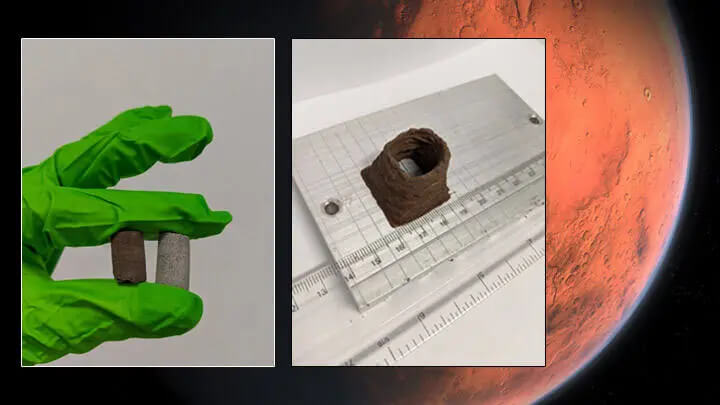
Scientists at the University of Manchester have devised a new – and somewhat macabre – way to turn Martian soil into a stronger material(Cosmic Concrete) for the construction of future colonies on the red planet.

Right: 3D printed Mars biocomposite.
Credit: University of Manchester.
The cost of transporting a single brick to Mars has been estimated at around US $ 2 million, which means that future Martian colonists cannot bring their building materials, and will have to use whatever resources they can obtain on-site for buildings and shelters.
This is known as in situ resource utilization (or ISRU) and generally focuses on the use of loose rock and Martian soil (known as regolith) and scarce water deposits. However, there is an overlooked resource that, by definition, will also be available on any manned mission to the red planet: the crew themselves.
Blood, sweat and tears to build Cosmic Concrete
In an article published in the journal Materials Today Bio, the scientists demonstrated that a common blood plasma protein, human serum albumin, could act as a binder for simulated Moon or Mars dust to produce a concrete-like material.
The resulting new material, called AstroCrete, had compressive strengths of up to 25 MPa (megapascals), roughly the same as the 20-32 MPa seen in ordinary concrete.
However, the scientists found that incorporating urea – which is a biological waste product that the body produces and excretes through urine, sweat, and tears – could increase compressive strength by more than 300 %. The best performing material has a compressive strength of almost 40 MPa, substantially stronger than ordinary concrete.

Dr. Aled Roberts of the University of Manchester, who worked on the project, said the new technique has considerable advantages over many other proposed construction sites on the Moon and Mars.
“All this time we have been trying to develop viable technologies to produce concrete-like materials on the surface of Mars, but we never stopped to think that the answer might lie within us all the time,” he said.
Medieval technology
Scientists estimate that a crew of six astronauts could produce more than 500 kg of high-strength AstroCrete over the course of a two-year mission to the surface of Mars. Used as a sandbag mortar or heat-melted regolith bricks, each crew member could produce enough AstroCrete to expand the habitat and support an additional crew member, doubling the available housing with each successive mission.
Animal blood was historically used as a binder for mortar. “It is exciting that a great space-age challenge has found its solution based on inspiration from medieval technology,” said Dr. Roberts.
The Manchester team investigated the underlying binding mechanism and found that proteins in the blood are denatured, or “curdled,” to form an extended structure with interactions known as “beta-sheets” that holds the material together tightly.
“The concept is literally bloody,” Dr. Roberts concluded.
Please remember we all have different opinions, Think Before You Speak or Write Something that is cruel to Others. After all, We are only Humans. Wishing you clear skies and wide eyes. To share your experiences or just leave a comment there is a area below. Read or listen.
We are the change the world has been waiting for!
Have you witnessed an unidentified flying object?
You are not alone. Whether you think UFOs are black projects, extraterrestrial craft, something else altogether, or just don’t know, again, you are not alone!
Unconditional love. The road we all get to walk. Unconditional love is like the sun.
WE ARE THE DISCLOSURE !~ WE HAVE NEVER BEEN ALONE
Love and Regards,
Thank You,
Nancy Thames
Source: University of Manchester.


